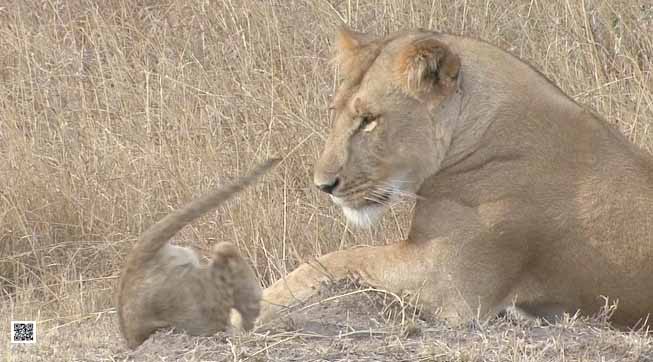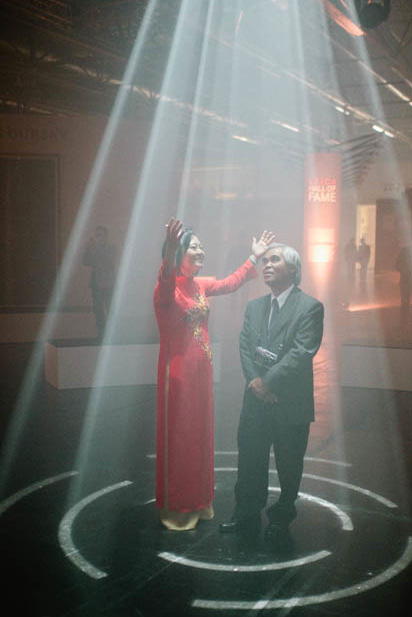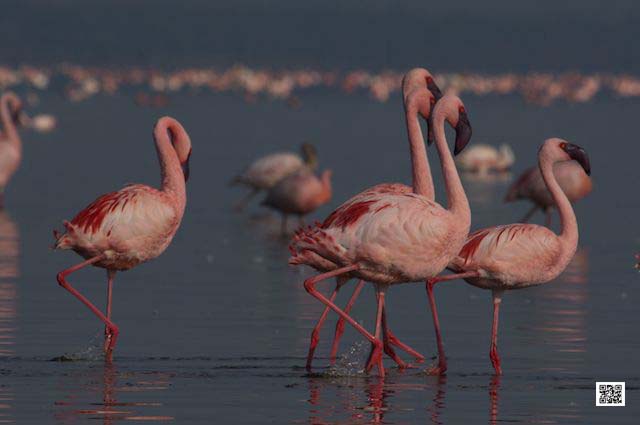23 September 2012
On Photo Safari: Watching a Lion Cub Learn
29/09/12 18:24 Filed in: Safari Story

How do lion cubs learn? Just as children by playing, falling and standing up and teasing the adults.
We were on photo safari in the Masai Mara when we spotted a lion pride with a little cub, as it turned out later the little star of the family. There were more sub adult young lion, but only one little cub, the baby of the family. Just as young children, little lion cubs love to play and by doing that they learn important skills for their life in the bush. In this case the little lion cub felt very confident with his mother and aunts around to explore the mount they were lying on. Unfortunately the mount had a whole on one side, what made a good rim to sit on, but for a “feeling confident” little cub it became a trap, not a dangerous one, but he made a good role head first into it. His mother watched him calmly and maybe even amused when he lost his balance and fell over into the whole. But no worries, he was just learning about his balance. He climbed out and found a new target, his older brothers. The first brother’s tail became the subject of learning how to bite in moving objects. His brother made in a gentle way clear that this was not what his tale was there for and the little cub moved on to the second brother. He did that by stalking him carefully, just like he would do during a hunt and then jumped on him, biting in his neck. His brother didn’t even move, the little one was to little to heart him and only practicing hunting. However, the little cub seemed very pleased with his results and took a nice nap using his brother’s belly as a pillow, before he embarked on new adventures of his young life.
Ute Sonnenberg for www.rohoyachui.com
Are all Photographers Don Quixotes?
28/09/12 07:33 Filed in: Photography & Art

Don Quixote: Dost not see? A monstrous giant of infamous repute whom I intend to encounter.
Sancho Panza: It's a windmill.
Don Quixote: A giant. Canst thou not see the four great arms whirling at his back?
Sancho Panza: A giant?
Don Quixote: Exactly.
(From Don Quixote by Miguel de Cervantes )
Have you ever experienced being with friends on a trip, watching a sunset and all of you are photographing the beautiful cloud formations. Each of you will have different photos and you might find yourself explaining your friends that you see a face in the clouds or a lamb or an old man. It might need some efforts to show them where you see it and then in return they start telling you what they see. At the end all of you see the faces and shapes in the pictures of the clouds all of you captured.
Imagine you are by yourself photographing the clouds in sunset and you post it to your social media pages. How many people will see the face and the lamb in the cloud? And how would you be surprised what else they see in your photo? They might not see the lamb and the face, yet all would see the photographer, the moment, the creativity and maybe a giant.
Ute Sonnenberg for www.rohoyachui.com
Seeing Your Workplace through Photography
27/09/12 09:35 Filed in: B2B

We all might have experienced days that we hated going to work, hated the office, the colleagues and anything else that comes with it. Mostly ideas of quitting and going away to better places are coming up; a feeling of wanting to run away becomes very strong. But often this fades away and we stay where we are with a bit of a bitter aftertaste and an uncomfortable feeling about ourselves. This is not necessary. There might have been something that had bothered us and we couldn’t figure out what it was. It might have not even been work related after all; just nagging us and we thought it was work. So going away wouldn’t have made any sense.
Nonetheless these “moments” can be experienced as very unpleasant and disturbing, especially when you can’t find out what it is. In this case think of photography and use it to help you. You will most likely have a camera in your cell phone and the phone will be with you at work. Take photos during your workday and do it without thinking too much, just shoot away. Don’t look at them while you are still at work. Go home, upload the images onto your computer and have a look at them. Maybe even wait until after dinner and then start seeing your workplace with the distance, yet connection a photographer has. You might see things you have never noticed that they are there or you will see your coworkers with different eyes or you will wonder why your desk is such a mess. With this distant view you will go back to work the next morning and it will be different. You might change how you do things, you might talk to your colleagues or you might realize how much you like your work. Whatever it is, the images will have helped you seeing and the unpleasant feeling might have disappeared.
Try it.
Ute Sonnenberg for www.rohoyachui.com
The Joys of Macro Photography
26/09/12 08:50 Filed in: Photography & Art

How often do you do macro photography? You probably answer, not often enough, and that might be a pity. We walk passed flowers every day, our houses and gardens are full with all sorts of little things and creatures (the creatures should be in the garden ) and we miss these opportunities for great photography. Did you ever take a good look at the pattern of the blanket you cuddle in when you watch TV or the colors and shapes of your herb jars?
Macro photography is fascinating and it doesn’t need much to do it, even the iPhone lens can be turned into a macro lens and off you go. See how to do that with this Snapguide and keep in mind the water goes only onto the lens!

More sophisticated and with beautiful result is the work of David Chambon. His insects look exactly like jewelry insects, only that the dew is then made of diamonds or crystals. Most likely the dew came first and was the inspiration for the jewelry artists, however, the images are stunning and very inspiring.
Lets get the lens out shoot macro!
Ute Sonnenberg for www.rohoyachui.com
In the Ray of Light: Nick Ut & Kim Phuc
25/09/12 16:28 Filed in: Photography & Art

Their lives are connected; maybe even before Nick Ut took the iconic photo of the Napalm Girl, definitely since he took the image that helped to end the Vietnam War.

And now they are here, together in this ray of light at the Exclusive Leica Launch Party on the Photkina last week, the photographer and his “subject”, Kim Phuc, the “Napalm Girl”. How must that feel standing there together after all these years? Does one relive the moment of the initial contact? How must it be for the photographer, looking at the woman he photographed as a child in a very traumatic situation. How must it be for Kim Phuc, looking into the eyes of the man who captured her in a very vulnerable situation with dignity and respect?
Only they know the answers. But maybe all of us have moments we remember, taking a photo that touched us deeply and how we felt or would feel to meet the “subject” again.
Imagine your ray of light.
Ute Sonnenberg for www.rohoyachui.com
Photo from photokina: Michael Zhang
Photo Napalm Girl: Nick Ut
Photokina: Camera Giants & Their News
24/09/12 11:06 Filed in: Photo Tips | Photography & Art

It is over for this year. The Photokina has closed her doors and photography lovers are still breathless from al the camera news that came over them, maybe secretly thinking already of buying one of the new models.
Probably the most bespoke new cameras are the Nikon D600 and the Canon 6D. Both are entry level DSLRs with a full-frame sensor and it makes complete sense to give them almost the same name. If you doubt which one to prefer, have a look at the sensor test from DxOMark and you will see that the result is not surprising.
While the Nikon D600 and the Canon 6D still have a reasonable price, other brands like Leica and Hasselblad introduced more pricy new camera models. They are the Leica M and the Hasselblad Lunar. Well they are great cameras, with an even great price.
For a nice overview and to compare the new camera models from the Photokina, have a look at the WEX page. More detailed tests will only be executed now, so more information on the new cameras will be available soon.
Fortunately Christmas is coming soon and Father Christmas might make one or the other camera dream come true.
Happy snapping!
Ute Sonnenberg for www.rohoyachui.com
Travel Memories 2008: On Safari in Africa - Day 4
23/09/12 10:44 Filed in: Travel & Inspiration | Photo Safari

The night was quiet. I heard again the breathing next to my head, which was a hippo according to Alex, grazing at night around the tents.
We left the campsite at about 8.30 a.m. and headed towards Nakuru, our next stop. Paul said we are taking a short cut to Narok, but this wasn’t really the case. We headed away from Narok and made some kind of a circle back onto the tar road. My guess was that we had to avoid driving through the reserve, like we did on the first day, The itinerary was mixed up and we hadn’t paid the park fee for the last day. Anyway our drive brought us along lots of animals and led us through a flood plane, which was the less nice part. All black cotton soil and wet, which is like driving on wet soap and one makes a good chance to get stuck. But we made it without bigger difficulties and hit the tar road to Narok. From Narok we followed the road back to Mai Maihiu and instead of turning right to Nairobi we headed north towards Naivasha and Nakuru. The drive was without any incidents, at least for us. There was a turned over Matatu on the side of the road. Fortunately nobody seemed to be hurt, although the faces looked in shock.
We arrived in Nakuru and to my surprise the Lake Nakuru National Park is only 10 min away from the city centre. The campsite was just behind the gate next to the ranger post under the cover of fever trees and in sight of the lake with its pink ribbon of flamingos along the shore. It was so tempting to just go there and have a look at the flamingos, but Paul reminded me that just recently a ranger got killed by a lion just in front of the ranger post.
We pitched camp and it was raining again. There was supposed to be somebody from the office in Nairobi with flysheets and a new fridge. He arrived just before dinner and the flysheets turned out to be impossible to use. They were big and heavy, made from some kind of synthetic leather, you use in car interiors. The first difficulty was that we needed trees to hang on the sheets, because there were no poles. When we fixed that, the sheets started soaking water and became even heavier what made them hanging down on the tent which collapsed, because of the weight. Anyway, it was late, we were tired and I just wanted to sleep in a not leaking tent. We postponed the sheet issue to the next morning.
We had dinner and suddenly a truck arrived on the campsite. Such a big lorry transformed into an overland bus. I learned that these trucks are doing tours from Nairobi to Cape Town and stop at the campsites in the National Parks. It was like watching a show. Maybe about thirty people pitched camp and had dinner. This happened like a military operation. Always two people fetched and pitched a tent until the camp was set, without any space between the tents and in a correct circle around the cooking area. It took them 15 minutes to do that. Then a designated group started cooking other groups looked after the table settings and other jobs that had to be done. There was no waste of time and manpower. After dinner within 15 minutes everybody was in the tents and ready to sleep. I was wondering if those people were on holidays.
We had an early night too. It was a long day.
Tweet.
Ute Sonnenberg for www.rohoyachui.com